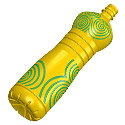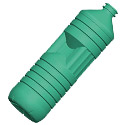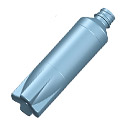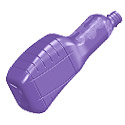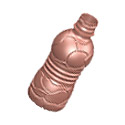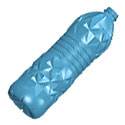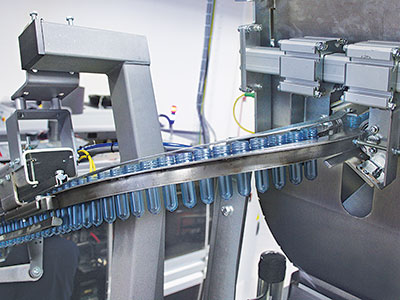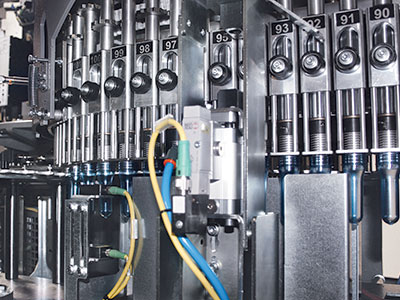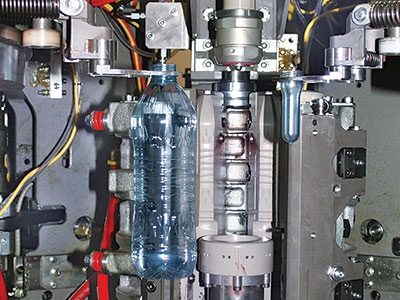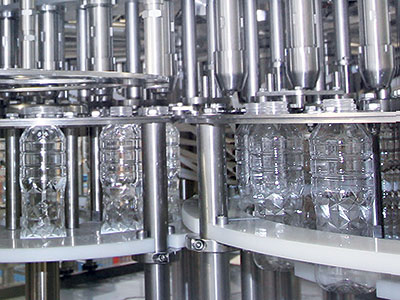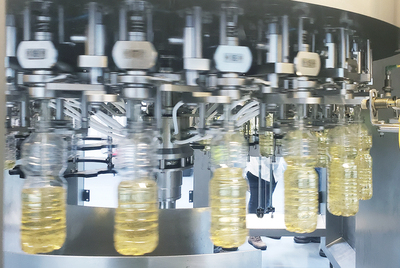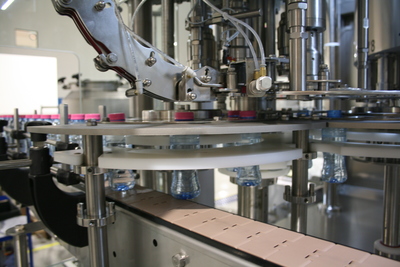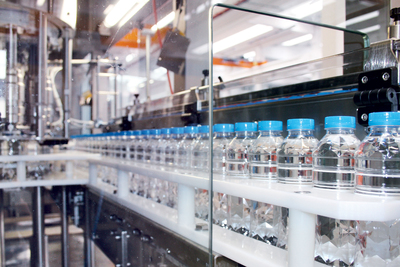Integrated stretch-blow moulding, filling and capping systems
ECOBLOC® HEMF series - oil
ECOBLOC® ERGON HEMF - Stretch-blow moulding, filling and capping integrated systems for oil
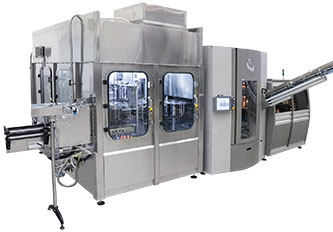
The models from ECOBLOC® HEMF range are the ideal solution for manufacturing, filling and capping PET, rPET and PP containers of different sizes and shapes, from the simplest to the most complex and innovative. Combining stretch-blow moulding, filling and capping functions into a single machine offers several advantages, since the rinser and conveyors between the stretch-blow moulder and the filler are not needed, the risks of product contamination are minimized and the causes of the line inefficiency are eliminated.
ECOBLOC® HEMF integrated systems can be used in the bottling lines of:
- not electrically conductive products, especially oil
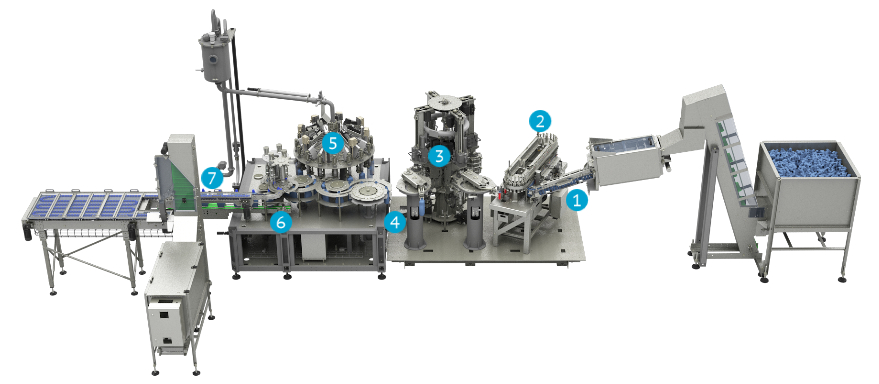
1Preforms feeding
The preforms are transferred from the hopper to the unscrambler through a lifting belt; the unscrambler conveys them to an inclined guide, from where they reach the spacer star wheel at the heating module infeed, by gravitational fall. The star wheel feeds the rotary mandrel chain, through which the preforms are “captured” and let into the heating module.
2Preforms heating
Before entering the heating module, equipped with infrared lamps, each preform undergoes accurate checks, which detect its size and vertical position and automatically eliminate the preforms not compliant with the pre-set parameters. The preforms, supported by the mandrels, start moving along the heating module. During the heating process, the preforms constantly turn around themselves, so as to ensure an excellent and symmetrical heat distribution. The heating module is equipped with two different cooling systems: a liquid-fed cooling system, in order to cool the protection ring preventing the preforms thread deformation during the heating process; an air-fed cooling system, in order to keep the temperature inside the heating module as low as to avoid the exposure of the preforms outside walls to too high temperatures. At the heating module outlet, a sensor detects the preform temperature and compares it with the temperature set point; if the two values do not correspond, it increases or decreases the heating module lamps power.
3Preform stretch blow-molding
A special rotary group of grippers picks up the preforms from the oven and sets them into the stretch-blowing stations. The stretch-blowing process includes two phases:
- stretching and pre-blowing, which occur simultaneously through the descent of the motorized stretching rod and the supply of low-pressure compressed air;
- final blowing with high-pressure compressed air, through which the containers take their final shape. A counter-pressure air system ensures the perfect locking of the moulds, whereas the mechanical locking of the mold-holders allows bearing the strengths generated by the stretch-blow moulding process with the maximum reliability. Also the stretch-blowing stations are equipped with a liquid-fed cooling system, which keeps the molds temperature constant.
4Empty bottles transfer
After being manufactured by the stretch-blow moulding machine, empty bottles are conveyed from the blower to the filler by "neck-handling" direct transfer by menas of adjoining star wheels. The star-wheel at the blowmoulder outlet is equipped with grippers electronically synchronised with the brackets of the starwheel at the filler inlet.
5Filling
Once the filling station is reached, a gripper grabs the bottle by the neck and places it under the filling valve.
The product to be filled is positioned in an external manifold, from which, through a specific pump, it is conveyed to the filling valve. The filling is massive, electronic with mass flow meters based on Coriolis principle and placed upstream of each filling valve.
During the filling process, the flow meter detects the amount of product that goes through the valve. The measurement is based on pulses, that are compared to the ones set for the format in use. When the set value is reached, the closure sign is sent to the filling valve.
At this stage the filled bottle is transferred to the capper.
6Capping
A shaped star wheel allows to center the bottle under its capping station. The cap coming from the feeding system is picked by a transfer star wheel called “pick and place”. The capping head picks the cap from the star wheels and applies it to the bottle. According to the cap to be applied (plastic screw cap or pressure cap), the capping system can operate by rotation or pressure.
The filled and capped bottle is transferred to the outfeed conveyor.
7Outfeed conveyor
The filled and capped bottles are transferred to a chain conveyor that conveys the bottles outside the machine. This conveyor is equipped with an automatic height adjusting system, that allows to adjust the bottle base according to the bottle height.
- Modular, compact frame, with large possibility of customization
- Perfect separation between the “dry” environment of the stretch-blow moulding module and the “wet” environment of the filling module
- Direct bottle transfer by means of adjoining star wheels (neckhandling style with pitch circle diameter)
- Stretch-blow moulding stations characterized by a low dead volume thanks to high-performance valves and optimized circuits
- Fully electronic control of the filling cycle
- High precision system, for the application of screw and pressure caps
- Easy and quick format changeover
- Great quality-price ratio
Compact solution
The integration of stretch-blow moulding, filling and capping functions into a single machine allows to considerably reduce costs, as well as the space occupied by the solution, since the rinser and conveyors between the stretch-blow moulder and the filler are not needed. This also leads to reduce contamination risks and to reach a higher hygiene level.Rotary stretch-blow moulding system
High-efficiency rotary stretch-blow moulding system equipped with motorized stretch rods, whose functioning, controlled electronically, does not need pneumatic cams. This allows a precise management of the rod path and an accurate control of its position, as well as a significant energy saving.Reduction of blowing times
The new valves provide a faster reaction and a saving by 15% on the useful blowing time; this time saving can be used to reach higher speeds, let the bottle cooled down or obtain a compromise between the two things.Maximum filling precision
The filling process is extremely precise, thanks to the use of the flow meter, an electronic device installed near each valve that detects the flow of the product that fills each bottle by counting the pulses and sends the filling valve the closure sign, once the value of the format in use is reached.High-precision mass flow meter
The high-precision mass flow meter (flow meter that uses the Coriolis effect in order to determine the exact amount of product at each passage), installed next to the filling valves., allows to get a quick measure with a greater repeatability. The flow meters are characterized by a high stability, with less need for calibration. During the measurement, the impact of the environmental conditions (mechanical vibrations, shaking, sprays, etc) is minimal. Moreover, there is no volume limit (the container size is not limited by the range of load cells). The control of the filling valve and the automatic compensation is performed through PLC.No drop filling valve
HEMF series is equipped with a special no drop filling valve for filling oil in PET containers, with specific anti-drip function at the end of the filling process.Contact us
- SMI S.p.A.
- Address: Via Carlo Ceresa, 10
24015 San Giovanni Bianco BG
Italy - Phone: +39 0345 40.111
- E-mail: info@smigroup.it
- Monday - Friday: 07:45 - 17:30
Saturday - Sunday: Closed
Privacy statement
DATA PROTECTION AND PRIVACY

The European Regulation 679/2016 (GDPR) on the protection of personal data has been fully applicable since May 25th, 2018. This is an important goal, because it lays down rules relating to the processing of personal data for all Countries within the Union. Every company of the SMI Group planned a series of activities, assets or operational modes to comply with the regulation and put into practice the protection of personal data. Here is a list of actions taken to comply with the European Regulation and our policy on personal data processing.
![]()
Lawfulness of processing
All activities relating to personal data processing shall be lawful (consent, contract obligations, vital interests of the data subject or of third parties, compliance with legal obligations to which the controller is subject, public interest or exercise of official authority, legitimate interest pursued by the controller or by third parties).
![]()
Information document
The information statement has been improved and updated to the new regulations (art. 13 and 14 GDPR).
![]()
Rights of the data subjects (right of access, right to erasure-right to be forgotten, right to restriction of processing, right to object, right to data portability)
Technical and organization measures have been adopted to ensure the data subject's exercise of his rights and to meet the data subject requirements.
![]()
Controllers, processors
Based on the new principle of “accountability”, SMI Group organization was re-defined, in order to proactively ensure integral compliance with the Regulation.
Redefinition of the role of data processors and service suppliers whose activity implies personal data processing.
![]()
Risk of data processing; accountability measures taken by controllers and processors (Impact assessment, record of processing activities, security of processing, data breach)
The “Conformity document”, including records of data processing activity, plans, adopts and demonstrates all technical and organizational measures taken to adequately perform the data processing activities and specifies the necessary procedures to be adopted to notify data breach.
![]()
Transfer of personal data to international organizations
Smi Group adheres to the general principles and guarantees concerning the transfer of personal data to third Countries.
The Controller is:
SMI S.p.A.
Head office: Via Carlo Ceresa, 10 - 24015 San Giovanni Bianco (BG) - ITALIA
P.I.: 04471940165 - C.F.: 03942700166 - R.E.A.: 421708
For further information, write to: privacy@smigroup.net
According to the European Regulation 679/2016, the data subject is entitled to exercise the rights set forth in the Regulation.
The integral version of art. 15; 16; 17; 18; 20; 21; 77 of the European Regulation is attached to this document.
In order to exercise your rights, please send the application form duly filled in to the Controller's address.
Legal notice
SMI S.p.A. con Unico Socio
Società sottoposta a direzione e coordinamento da SMIGROUP S.p.A.
Società appartenente al GRUPPO IVA SMI INDUSTRIES
Sede amministrativa e Unità produttiva:
Via Carlo Ceresa, 10 - 24015 San Giovanni Bianco (BG) - ITALIA
Tel. +39 0345 40.111 - Fax: +39 0345 40.209 - www.smigroup.it
C.F. 03942700166 - P. IVA IT04471940165 - R.E.A. 421708
Iscr.Reg.Imprese 03942700166 - Cap. Soc. € 5.000.000 i.v.
Sede legale: Via Monte Grappa, 7 - 24121 Bergamo (BG) - ITALIA











